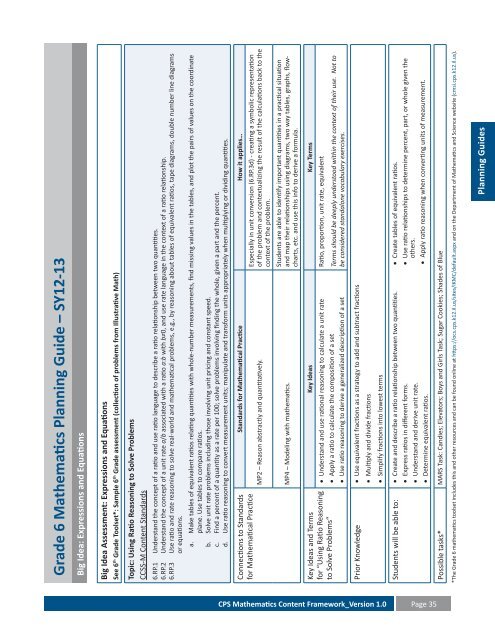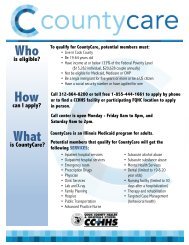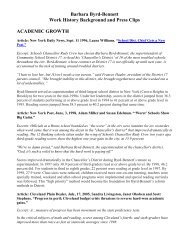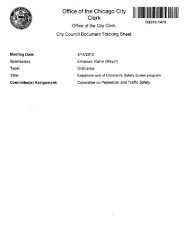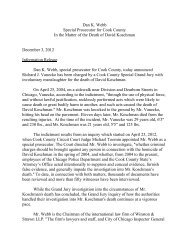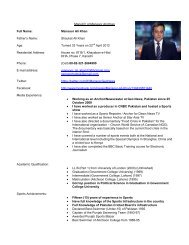Mathematics Content Framework - Chicago Public Schools
Mathematics Content Framework - Chicago Public Schools
Mathematics Content Framework - Chicago Public Schools
You also want an ePaper? Increase the reach of your titles
YUMPU automatically turns print PDFs into web optimized ePapers that Google loves.
Grade 6 <strong>Mathematics</strong> Planning Guide – SY12-13<br />
Big Idea: Expressions and Equations<br />
Big Idea Assessment: Expressions and Equations<br />
See 6th Grade Toolset*: Sample 6th Grade assessment (collection of problems from Illustrative Math)<br />
Topic: Using Ratio Reasoning to Solve Problems<br />
CCSS-M <strong>Content</strong> Standards<br />
6.RP.1 Understand the concept of a ratio and use ratio language to describe a ratio relationship between two quantities.<br />
6.RP.2 Understand the concept of a unit rate a/b associated with a ratio a:b with b≠0, and use rate language in the context of a ratio relationship.<br />
6.RP.3 Use ratio and rate reasoning to solve real-world and mathematical problems, e.g., by reasoning about tables of equivalent ratios, tape diagrams, double number line diagrams<br />
or equations.<br />
a. Make tables of equivalent ratios relating quantities with whole-number measurements, find missing values in the tables, and plot the pairs of values on the coordinate<br />
plane. Use tables to compare ratios.<br />
b. Solve unit rate problems including those involving unit pricing and constant speed.<br />
c. Find a percent of a quantity as a rate per 100; solve problems involving finding the whole, given a part and the percent.<br />
d. Use ratio reasoning to convert measurement units; manipulate and transform units appropriately when multiplying or dividing quantities.<br />
Standards for Mathematical Practice How it applies…<br />
Connections to Standards<br />
for Mathematical Practice<br />
Especially in unit conversion (6.RP.3d) - creating a symbolic representation<br />
of the problem and contextualizing the result of the calculations back to the<br />
MP2 – Reason abstractly and quantitatively.<br />
context of the problem.<br />
Students are able to identify important quantities in a practical situation<br />
and map their relationships using diagrams, two way tables, graphs, flowcharts,<br />
etc. and use this info to derive a formula.<br />
MP4 – Modeling with mathematics.<br />
Key Ideas Key Terms<br />
• Understand and use rational reasoning to calculate a unit rate Ratio, proportion, unit rate, equivalent<br />
• Apply a ratio to calculate the composition of a set<br />
Terms should be deeply understood within the context of their use. Not to<br />
• Use ratio reasoning to derive a generalized description of a set be considered standalone vocabulary exercises.<br />
Key Ideas and Terms<br />
for “Using Ratio Reasoning<br />
to Solve Problems“<br />
• Use equivalent fractions as a strategy to add and subtract fractions<br />
• Multiply and divide fractions<br />
Prior Knowledge<br />
CPS <strong>Mathematics</strong> <strong>Content</strong> <strong>Framework</strong>_Version 1.0 Page 35<br />
• Simplify fractions into lowest terms<br />
• Create tables of equivalent ratios.<br />
• Use ratio relationships to determine percent, part, or whole given the<br />
others.<br />
• Apply ratio reasoning when converting units of measurement.<br />
• Create and describe a ratio relationship between two quantities.<br />
• Express ratios in different forms.<br />
• Understand and derive unit rate.<br />
• Determine equivalent ratios.<br />
Students will be able to:<br />
MARS Task: Candies; Elevators; Boys and Girls Task; Sugar Cookies; Shades of Blue<br />
Possible tasks*<br />
*The Grade 6 mathematics toolset includes this and other resources and can be found online at https://ocs.cps.k12.il.us/sites/IKMC/default.aspx and on the Department of <strong>Mathematics</strong> and Science website (cmsi.cps.k12.il.us).<br />
Planning Guides


